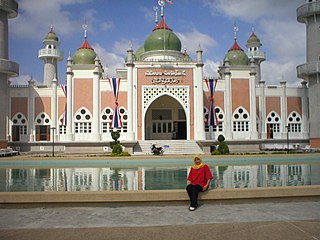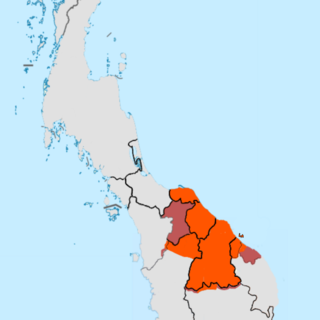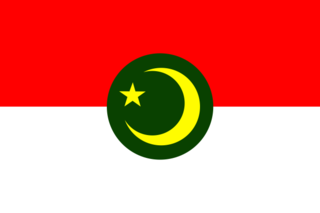
Pattani is one of the southern provinces of Thailand. Neighboring provinces are Narathiwat, Yala, and Songkhla. Its capital is the town of Pattani.

Narathiwat is one of the southern provinces (changwat) of Thailand. Neighboring provinces are Yala and Pattani. To the south it borders the Malaysian state of Kelantan and Perak. The southern railway line ends in this province, which is one of the nation's four provinces that border Malaysia. The province features a range of cultures as well as natural resources, and is relatively fertile. Narathiwat is about 1,140 kilometers south of Bangkok and has an area of 4,475 km2 (1,728 sq mi). Seventy-five percent of the area is jungle and mountains and has a tropical climate.

Satun (Thai: สตูล, pronounced[sā.tūːn] is one of the southern provinces of Thailand. Neighboring provinces are Trang, Phatthalung, and Songkhla. To the south it borders Perlis of Malaysia.

PataniDarussalam is a historical region and sultanate in the Malay peninsula. It includes the southern Thai provinces of Pattani, Yala (Jala), Narathiwat (Menara), and parts of Songkhla (Singgora). Its capital was the town of Patani.

Patani, or the Sultanate of Patani was a Malay sultanate in the historical Pattani Region. It covered approximately the area of the modern Thai provinces of Pattani, Yala, Narathiwat and part of the northern modern-day Malaysian state of Kelantan. The 2nd–15th century state of Langkasuka and 6–7th century state of Pan Pan may or may not have been related.

Islam is a minority faith in Thailand, with statistics suggesting 4.9% of the population are Muslim. Figures as high as 5% of Thailand's population have also been mentioned. A 2023 Pew Research Center survey gave 7%. Thai Muslims are the largest religious minority in the country.
Southern Thai, also known as Dambro, Pak Tai, or "Southern language", is a Southwestern Tai ethnolinguistic identity and language spoken in southern Thailand as well as by small communities in the northernmost Malaysian states. It is spoken by roughly five million people, and as a second language by the 1.5 million speakers of Pattani and other ethnic groups such as the local Peranakans communities, Negritos, and other tribal groups. Most speakers are also fluent in or understand the Central Thai dialects.

Kelantan-Pattani Malay is an Austronesian language of the Malayic subfamily spoken in the Malaysian state of Kelantan, as well as in Besut and Setiu districts of Terengganu state and the Perhentian Islands, and in the southernmost provinces of Thailand. It is the primary spoken language of Thai Malays, but is also used as a lingua franca by ethnic Southern Thais in rural areas, Muslim and non-Muslim and the Sam-Sam, a mostly Thai-speaking population of mixed Malay and Thai ancestry.

The South Thailand insurgency is an ongoing conflict centered in southern Thailand. It originated in 1948 as an ethnic and religious separatist insurgency in the historical Malay Patani Region, made up of the three southernmost provinces of Thailand and parts of a fourth, but has become more complex and increasingly violent since the early 2000s from drug cartels, oil smuggling networks, and sometimes pirate raids.

The Patani United Liberation Organisation is a separatist insurgent group in Thailand, calling for an independent Patani. It was founded in 1968 in Saudi Arabia. This organization composed the national anthem of Patani called Lagu Kebangsaan Patani.

The Barisan Revolusi Nasional Melayu Patani, also known by the shorter form Barisan Revolusi Nasional ), meaning "National Revolutionary Front", is an Islamist Patani independence movement in northern Malaysia and Patani, southern Thailand. As of 2017, it is the most powerful rebel group in the region.

Bersatu, also referred to as the Patani Malays People's Consultative Council was an umbrella group of separatist organisations of the predominantly Muslim and Malay provinces of Southern Thailand ("Patani").

Thai Malays, with officially recognised terms including 'Malayu-descended Thais' and 'Malay', is a term used to refer to ethnic Malay citizens of Thailand, the sixth largest ethnic group in Thailand. Thailand is home to the third largest ethnic Malay population after Malaysia and Indonesia and most Malays are concentrated in the Southern provinces of Narathiwat, Pattani, Yala, Songkhla, and Satun. Phuket Ranong, and Trang home to a sizeable Muslim population, also have many people who are of Malay descent. A sizeable community also exists in Thailand's capital Bangkok, having descended from migrants or deportees who were relocated from the South from the 13th century onwards.

Krue Se Mosque also called Gresik Mosque, Pitu Krue-ban Mosque or Sultan Muzaffar Shah Mosque, is a mosque in Pattani Province, Thailand. Its construction may have begun in the 16th century. The surviving structure is described as having a mixture of Middle Eastern or European architectural styles.

The Rohingya conflict is an ongoing conflict in the northern part of Myanmar's Rakhine State, characterised by sectarian violence between the Rohingya Muslim and Rakhine Buddhist communities, a military crackdown on Rohingya civilians by Myanmar's security forces, and militant attacks by Rohingya insurgents in Buthidaung, Maungdaw, and Rathedaung Townships, which border Bangladesh.
The Kumpulan Mujahidin Malaysia (KMM), or Malaysian Mujahideen Movement, is/was a terrorist organisation that supported an overthrow of the Mahathir government and is/was for the creation of a pan-regional Islamic state comprising southern Thailand, the entirety of Indonesia, and the southern Philippines. It is believed to be self-financing and is often tied in correlation to smaller more extremist groups in Southeast Asia. The KMM is often cited as being associated with the Jemaah Islamiyah or JI. The Malaysian government, which is actively fighting against the Malaysian Mujahideen Movement, has arrested anywhere from 70 to 80 terrorists. The government currently has 48 members in total detained.
The Pattani Islamic Mujahideen Movement is an Islamic insurgent movement that has carried out violent actions as part of the protracted insurgency in Southern Thailand.

The 15th Infantry Division (พล.ร.๑๕.) is an infantry division of the Royal Thai Army, it is currently a part of the Fourth Army Area. The unit is composed of the 151st Infantry Regiment, 152nd Infantry Regiment and 153rd Infantry Regiment and Service Support Regiment. The division engaged in the South Thailand insurgency.













